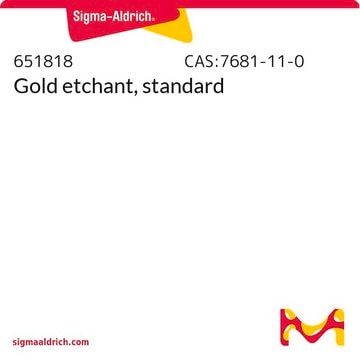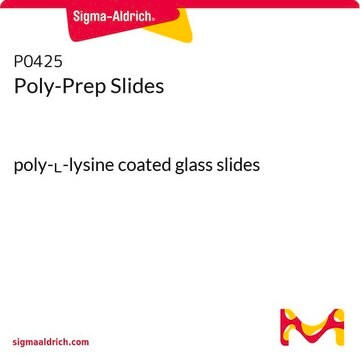643246
Goldbeschichteter Glasobjektträger
99.999% (Au), layer thickness 1000 Å
About This Item
Empfohlene Produkte
Assay
99.9% (Ti)
99.999% (Au)
L × B × Dicke
3 in. × 1 in. × 0.7 mm
Schichtdicke
1000 Å
Durchlässigkeit
380-700, >91% (for the glass microscope slide alone)
Brechungsindex
n20/400 1.52 (lit.)
Matrixanbindung
Titanium, as adhesion layer used to bind the gold to the aluminosilicate glass cover slip
SMILES String
[Au]
InChI
1S/Au
InChIKey
PCHJSUWPFVWCPO-UHFFFAOYSA-N
Suchen Sie nach ähnlichen Produkten? Aufrufen Leitfaden zum Produktvergleich
Verwandte Kategorien
Anwendung
- Einfache Oberflächenmodifikation von Polydimethylsiloxan für die DNA-Hybridisierung: Unterstreicht die Anwendung von goldbeschichteten Glasobjektträgern bei der Entwicklung effektiver Biosensoren für die DNA-Hybridisierung und unterstützt Innovationen in Genomik und pharmazeutischer Forschung (Zhou et al., 2010).
- Multimodale Spektroskopie, die Flugzeit-Sekundärionen-Massenspektrometrie, Synchrotron-FT-IR und Synchrotron-UV-Mikrospektroskopie auf demselben Gewebeschnitt kombiniert: Verwendung von goldbeschichteten Glasobjektträgern zur Integration mehrerer spektroskopischer Techniken zur Verbesserung der Analyse komplexer biologischer Proben, die für die innovative Forschung in Biochemie und Materialwissenschaften von entscheidender Bedeutung sind (Petit et al., 2010).
Leistungsmerkmale und Vorteile
Sonstige Hinweise
Lagerklassenschlüssel
11 - Combustible Solids
WGK
nwg
Flammpunkt (°F)
Not applicable
Flammpunkt (°C)
Not applicable
Analysenzertifikate (COA)
Suchen Sie nach Analysenzertifikate (COA), indem Sie die Lot-/Chargennummer des Produkts eingeben. Lot- und Chargennummern sind auf dem Produktetikett hinter den Wörtern ‘Lot’ oder ‘Batch’ (Lot oder Charge) zu finden.
Besitzen Sie dieses Produkt bereits?
In der Dokumentenbibliothek finden Sie die Dokumentation zu den Produkten, die Sie kürzlich erworben haben.
Kunden haben sich ebenfalls angesehen
Artikel
Synthesis of Melting Gels Using Mono-Substituted and Di-Substituted Alkoxysiloxanes
Protokolle
SAMs are versatile surface coatings for chemical resistance, bio-compatibility, sensitization, and molecular recognition for sensors and nano fabrication.
Unser Team von Wissenschaftlern verfügt über Erfahrung in allen Forschungsbereichen einschließlich Life Science, Materialwissenschaften, chemischer Synthese, Chromatographie, Analytik und vielen mehr..
Setzen Sie sich mit dem technischen Dienst in Verbindung.







